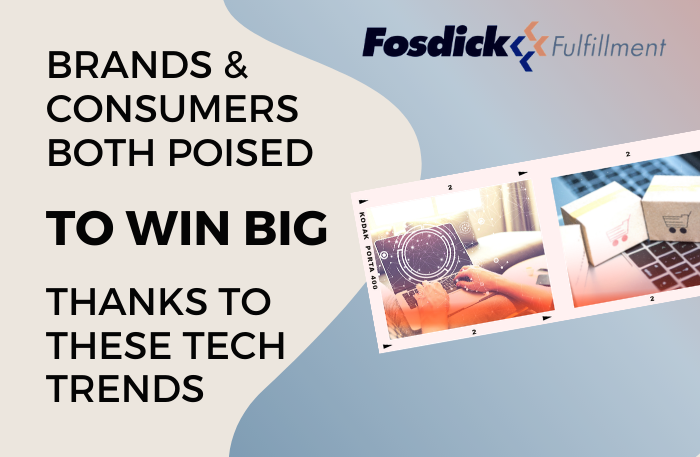April’s headlines have added some high octane fuel onto the already white hot ecommerce sector. What is already a tech heavy space now seems to be approaching Elon Musk levels with trending innovation on both the consumer and merchant sides.
We started here: A Shopify report titled: 5 Trends for the Future of eCommerce in 2021. Just as the title promises, the downloadable PDF asserts Shopify’s predictions for online shopping and the potential impact of each on DTC brands and vendor services.
The report also lays out the methodology behind the trends featured, emphasizing “nuanced, region specific, and actionable” data “reviewed by the best minds in commerce.” The final list is the culmination of more than 24 internal surveys of Shopify merchants across North America, Asia, Europe, and the Middle East.
The Shopify report also draws on third party data from some of our favorite resources here at Fosdick including Statista, eMarketer, Global Web Index, Google, IBM, Deloitte, ACcenture, Gartner, McKinsey, Forrester, Nielsen, and the WTO.
As for the trends themselves…
If you’re in the eCommerce brand business, or a vendor service working closely with DTCs, then you’re familiar with the processes and practices highlighted. Afterall, a trend implies change. Not revolutionary change, but change that is in vogue.
The concept of omnichannel (trend 1), for instance, was first introduced around 2010. What’s exciting, though, is the scale at which brands are beginning to apply omnichannel solutions, as well as some of the other trends listed.

- TREND 1: Ecommerce boom fuels record online competition
- DTC brands prioritize seamless omnichannel experience to win new customers.
This is big, but also buzz-wordy. Omnichannel means a lot of things to a lot of people, ourselves included. But we have spent a lot of time thinking about one particular realm of the omnichannel as it relates to eCommerce, and more specifically, mobile commerce.
We posted blog content back in September of last year all about mobile commerce and why we just don’t do it well in the US (relative to Asia, for example). The issue, as we understand it, has been the lack of viable digital payment solutions.
In 2020, however, we discovered the beginnings of what is shaping up to be a digital payment revolution. Back then, none of us suspected the timeliness of a fintech surge, and yet here we are post pandemic with Gen Z aging into a consumer demographic that almost exclusively shops on their phones!
What’s more, this month’s business news was littered with headlines pertaining to digital payment breakthroughs:
China Creates Its Own Digital Currency, a First for Major Economy
Square’s Cash App is Hiring to Build its Own Payments Network
-
- TREND 2: New consumer behaviors reshape the future of retail
- Brands bulb creative new digital experiences to unlock the future of retail.
Vague, for sure. Still, we second the importance of experiential retail in the digital realm, especially for brands. Start-up DTC and subscription based companies MUST consider innovating around customer experience through the lens of the pandemic.
Operating as though its still March of 2020 forces companies to develop customer centric shopping experiences that are both engaging and digitally native! Think – the Canada Goose cold room, but online.
In all seriousness, though, the brands that do online customer experience well do so with (internet) age old tactics like personalization (i.e. curated apparel boxes like the Frank and Oak Style Plan), actual communication (think SMS marketing), great storytelling and documentation (i.e. the Harry’s factory page), self-service, & more.
Here is a better resource than us from Core DNA outlining exactly what a great online customer experience looks like practically.
-
- TREND 3: Fulfillment emerges as a competitive differentiator
- Consumers gravitate to brands offering fast, free, sustainable shipping.
Now this we CAN speak to with a little more confidence. Bottom line, fast and free is the new standard. Sustainable is the premium service for which millennial and gen z consumers (the majority of online shoppers) will pay top dollar.
We’ve talked about this in pretty great deal in previous issues, primarily through the lens of a 2019 BigCommerce report featured in a very early issue of Last Month in Fulfillment (Vol. 1, No. 4).
At Fosdick, all three (fast, free, sustainable) are priorities. In fact, we were included among Multichannel Merchants Top 3PL’s for 2021 in part for our ability to provide 2 day shipping to 80% of the continental US.
-
- )TREND 4: Brand building challenged by marketplace dominance
- New search and purchasing habits cause brands to personalize with a human touch.
Think back to the heart of the pandemic and this story about BirchBox customer relations amidst a world of shipping issues, the likes of which our industry may never see again (hopefully).
- TREND 5: Retention becomes a top priority as acquisition costs spike
- Brands experiment with new channels as digital advertising uncertainty rises.
The days of user centric companies getting billion dollar valuations despite massive marketing spends and ZERO profitability are over. 2020 reminded us all that making money is fundamental to good business. New user data is not dollars earned. More times than not, its dollars spent. Living alongside the actual bottom line is retention and the methods by which brands ensure their customers stay customers for a long time to come.

